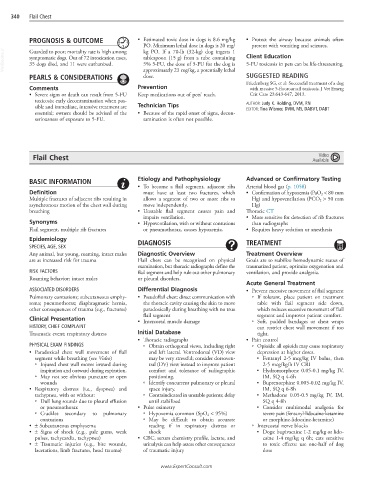Page 728 - Cote clinical veterinary advisor dogs and cats 4th
P. 728
340 Flail Chest
PROGNOSIS & OUTCOME • Estimated toxic dose in dogs is 8.6 mg/kg • Protect the airway because animals often
PO. Minimum lethal dose in dogs is 20 mg/ present with vomiting and seizures.
VetBooks.ir symptomatic dogs. Out of 72 intoxication cases, tablespoon (15 g) from a tube containing Client Education
kg PO. If a 70-lb (32-kg) dog ingests 1
Guarded to poor; mortality rate is high among
5% 5-FU, the dose of 5-FU for the dog is
5-FU toxicosis in pets can be life-threatening.
35 dogs died, and 11 were euthanized.
PEARLS & CONSIDERATIONS approximately 23 mg/kg, a potentially lethal SUGGESTED READING
dose.
Friedenberg SG, et al: Successful treatment of a dog
Comments Prevention with massive 5-fluorouracil toxicosis. J Vet Emerg
• Severe signs or death can result from 5-FU Keep medications out of pets’ reach. Crit Care 23:643-647, 2013.
toxicosis; early decontamination when pos- AUTHOR: Judy K. Holding, DVM, RN
sible and immediate, intensive treatment are Technician Tips EDITOR: Tina Wismer, DVM, MS, DABVT, DABT
essential; owners should be advised of the • Because of the rapid onset of signs, decon-
seriousness of exposure to 5-FU. tamination is often not possible.
Video
Flail Chest Available
BASIC INFORMATION Etiology and Pathophysiology Advanced or Confirmatory Testing
• To become a flail segment, adjacent ribs Arterial blood gas (p. 1058)
Definition must have at least two fractures, which • Confirmation of hypoxemia (PaO 2 < 80 mm
Multiple fractures of adjacent ribs resulting in allows a segment of two or more ribs to Hg) and hypoventilation (PCO 2 > 50 mm
asynchronous motion of the chest wall during move independently. Hg)
breathing • Unstable flail segment causes pain and Thoracic CT
impairs ventilation. • More sensitive for detection of rib fractures
Synonyms • Hypoventilation, with or without contusions than radiographs
Flail segment, multiple rib fractures or pneumothorax, causes hypoxemia. • Requires heavy sedation or anesthesia
Epidemiology
SPECIES, AGE, SEX DIAGNOSIS TREATMENT
Any animal, but young, roaming, intact males Diagnostic Overview Treatment Overview
are at increased risk for trauma Flail chest can be recognized on physical Goals are to stabilize hemodynamic status of
examination, but thoracic radiographs define the traumatized patient, optimize oxygenation and
RISK FACTORS flail segment and help rule out other pulmonary ventilation, and provide analgesia.
Roaming behavior; intact males or pleural disorders.
Acute General Treatment
ASSOCIATED DISORDERS Differential Diagnosis • Prevent excessive movement of flail segment
Pulmonary contusions; subcutaneous emphy- • Pseudoflail chest: direct communication with ○ If tolerant, place patient on treatment
sema; pneumothorax; diaphragmatic hernia, the thoracic cavity causing the skin to move table with flail segment side down,
other consequences of trauma (e.g., fractures) paradoxically during breathing with no true which reduces excessive movement of flail
flail segment segment and improves patient comfort.
Clinical Presentation • Intercostal muscle damage ○ Soft, padded bandages or chest wraps
HISTORY, CHIEF COMPLAINT can restrict chest wall movement if too
Traumatic event; respiratory distress Initial Database tight.
• Thoracic radiographs • Pain control
PHYSICAL EXAM FINDINGS ○ Obtain orthogonal views, including right ○ Opioids: all opioids may cause respiratory
• Paradoxical chest wall movement of flail and left lateral. Ventrodorsal (VD) view depression at higher doses.
segment while breathing (see Video) may be very stressful; consider dorsoven- ■ Fentanyl 2-5 mcg/kg IV bolus, then
○ Injured chest wall moves inward during tral (DV) view instead to improve patient 2-5 mcg/kg/h IV CRI
inspiration and outward during expiration. comfort and tolerance of radiographic ■ Hydromorphone 0.05-0.1 mg/kg IV,
○ May not see obvious puncture or open positioning. IM, SQ q 4-6h
wounds ○ Identify concurrent pulmonary or pleural ■ Buprenorphine 0.005-0.02 mg/kg IV,
• Respiratory distress (i.e., dyspnea) and space injury. IM, SQ q 6-8h
tachypnea, with or without: ○ Contraindicated in unstable patients; delay ■ Methadone 0.05-0.5 mg/kg IV, IM,
○ Dull lung sounds due to pleural effusion until stabilized SQ q 4-8h
or pneumothorax • Pulse oximetry ■ Consider multimodal analgesia for
○ Crackles secondary to pulmonary ○ Hypoxemia common (SpO 2 < 95%) severe pain (fentanyl-lidocaine-ketamine
contusions ○ May be difficult to obtain accurate or morphine-lidocaine-ketamine)
• ± Subcutaneous emphysema reading if in respiratory distress or ○ Intercostal nerve blocks
• ± Signs of shock (e.g., pale gums, weak shock ■ Dogs: bupivacaine 1-2 mg/kg or lido-
pulses, tachycardia, tachypnea) • CBC, serum chemistry profile, lactate, and caine 1-4 mg/kg q 6h; cats sensitive
• ± Traumatic injuries (e.g., bite wounds, urinalysis can help assess other consequences to toxic effects: use one-half of dog
lacerations, limb fractures, head trauma) of traumatic injury dose
www.ExpertConsult.com

